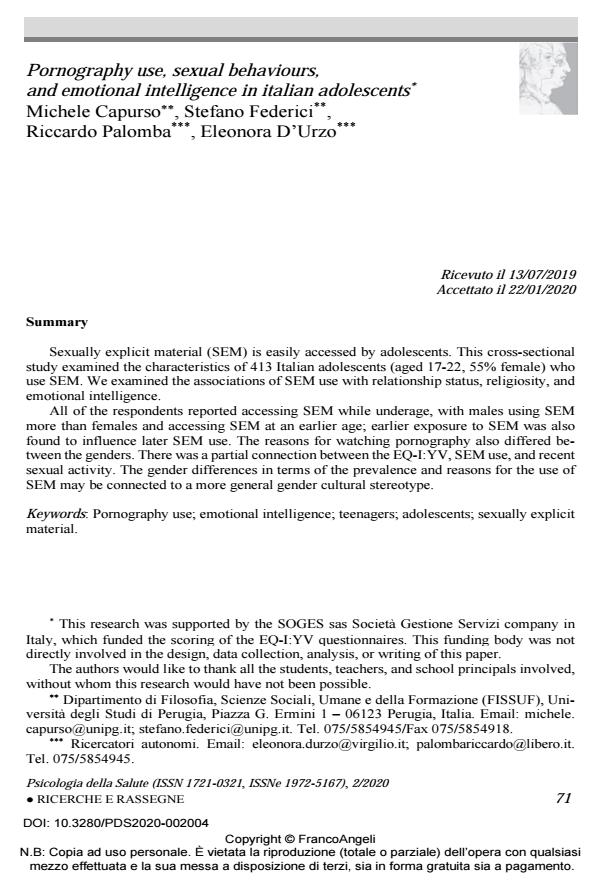Pornography use, sexual behaviours, and emotional intelligence in italian adolescents
Titolo Rivista PSICOLOGIA DELLA SALUTE
Autori/Curatori Michele Capurso, Stefano Federici, Riccardo Palomba, Eleonora D’Urzo
Anno di pubblicazione 2020 Fascicolo 2020/2
Lingua Inglese Numero pagine 26 P. 71-96 Dimensione file 319 KB
DOI 10.3280/PDS2020-002004
Il DOI è il codice a barre della proprietà intellettuale: per saperne di più
clicca qui
Qui sotto puoi vedere in anteprima la prima pagina di questo articolo.
Se questo articolo ti interessa, lo puoi acquistare (e scaricare in formato pdf) seguendo le facili indicazioni per acquistare il download credit. Acquista Download Credits per scaricare questo Articolo in formato PDF

FrancoAngeli è membro della Publishers International Linking Association, Inc (PILA)associazione indipendente e non profit per facilitare (attraverso i servizi tecnologici implementati da CrossRef.org) l’accesso degli studiosi ai contenuti digitali nelle pubblicazioni professionali e scientifiche
Sexually explicit material (SEM) is easily accessed by adolescents. This cross-sectional study examined the characteristics of 413 Italian adolescents (aged 17-22, 55% female) who use SEM. We examined the associations of SEM use with relationship status, religiosity, and emotional intelligence. All of the respondents reported accessing SEM while underage, with males using SEM more than females and accessing SEM at an earlier age; earlier exposure to SEM was also found to influence later SEM use. The reasons for watching pornography also differed be-tween the genders. There was a partial connection between the EQ-I:YV, SEM use, and recent sexual activity. The gender differences in terms of the prevalence and reasons for the use of SEM may be connected to a more general gender cultural stereotype.
Oggi gli adolescenti hanno facile accesso a materiale sessualmente esplicito (MSE). Il pre-sente studio trasversale ha preso in esame le caratteristiche di un gruppo di 413 adolescenti italiani (età 17-22, 55% femmine) che fanno uso di MSE. L’uso di MSE è stato analizzato in riferimento alla presenza di una relazione di coppia, alla intelligenza emotiva e alla religiosità. Tutti gli intervistati che hanno ammesso di usare MSE, hanno riferito di avere iniziato ad usare tale materiale prima della maggiore età. I maschi usano MSE più spesso delle femminine e iniziano ad una età più precoce. L’utilizzo precoce di MSE influenza inoltre il successivo uso di tale materiale. Maschi e femmine, inoltre, hanno riferito diverse ragioni per l’uso di MSE. È stato trovato un collegamento tra alcune componenti del test EQ-I:YV che misura l’intelligenza emotiva, l’uso di MSE e una recente attività sessuale. Le differenze di genere rilevate nello studio in termini di ragioni e prevalenza di uso di MSE potrebbero essere giustificate da stereotipo di genere di derivazione culturale.
Parole chiave:Uso della pornografia; intelligenza emotiva; adolescenti; materiale sessualmente esplicito.
- Pornography Consumption Among Young People: An Assessment of Parents’ and Teachers’ Training Needs Berta Vall-Castelló, Jaume Grané-Morcillo, Elena Lloberas-López-de-Sepúlveda, Berta Aznar-Martínez, Judith Lorente-De-Sanz, Letizia Baroncelli, Alessandra Pauncz, in Sexuality Research and Social Policy /2025 pp.1728
DOI: 10.1007/s13178-025-01080-0 - The (Un)Equal Effect of Binary Socialisation on Adolescents’ Exposure to Pornography: Girls’ Empowerment and Boys’ Sexism from a New Representative National Survey Loredana Cerbara, Giulia Ciancimino, Gianni Corsetti, Antonio Tintori, in Societies /2023 pp.146
DOI: 10.3390/soc13060146 - Parental Competence and Pornography Use among Hispanic Adolescents María Calatrava, Paola Alexandria Pinto de Magalhaes, Marta Vidaurreta, Sonia Rivas, Cristina López-Del Burgo, Maider Belintxon, in Behavioral Sciences /2024 pp.926
DOI: 10.3390/bs14100926 - Exploring Italian adolescents’ perspectives on online pornography and perceived harms Cosimo Marco Scarcelli, in New Media & Society /2025 pp.2513
DOI: 10.1177/14614448251333730
Michele Capurso, Stefano Federici, Riccardo Palomba, Eleonora D’Urzo, Pornography use, sexual behaviours, and emotional intelligence in italian adolescents in "PSICOLOGIA DELLA SALUTE" 2/2020, pp 71-96, DOI: 10.3280/PDS2020-002004